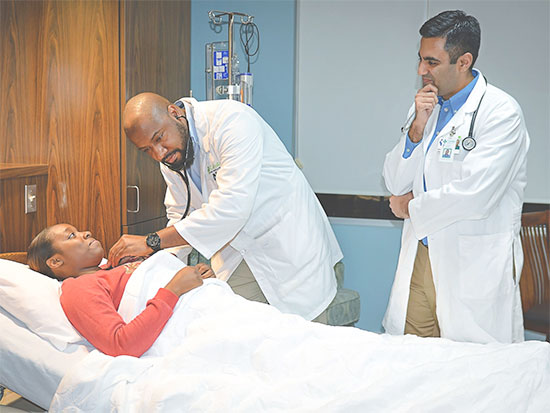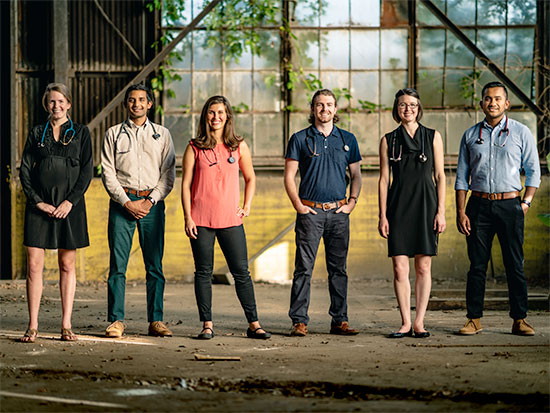 Cahaba Medical Care partners with UAB to train 12 medical residents in urban and rural settings each year.Alabama faces a dire shortage of primary care physicians, especially in rural and urban settings, prompting the University of Alabama at Birmingham to partner with Cahaba Medical Care, a family medicine group with clinics in Jefferson, Bibb, Perry, Chilton, Dallas and Autauga counties, in an innovative program aimed at providing high-quality care and enhancing the pipeline of family physicians.
Cahaba Medical Care partners with UAB to train 12 medical residents in urban and rural settings each year.Alabama faces a dire shortage of primary care physicians, especially in rural and urban settings, prompting the University of Alabama at Birmingham to partner with Cahaba Medical Care, a family medicine group with clinics in Jefferson, Bibb, Perry, Chilton, Dallas and Autauga counties, in an innovative program aimed at providing high-quality care and enhancing the pipeline of family physicians.
About 3,400 physicians are licensed in Alabama to practice in internal medicine or family practice, the two main primary care fields. That is about one for every 1,400 residents of the state. Since many physicians practice near major metropolitan areas, the problem of access to primary care is especially challenging in rural counties and underserved urban communities.
“Projections indicate that Alabama will face a shortage of more than 600 primary care providers by 2030 unless steps are taken now to recruit and retain family medicine physicians and other health care providers,” said Irfan Asif, M.D., chair of the UAB Department of Family and Community Medicine, who helped establish the partnership with Cahaba Medical Care.
Upon graduation from medical school, new physicians spend several years continuing their medical educations in their chosen field as residents. The partnership between UAB and Cahaba Medical Care will recruit 12 new graduates per year during the three-year residency, and residents will split their time between UAB’s hospitals and Cahaba’s rural or urban doctors’ offices.
“Most residency programs are housed strictly in hospitals,” said Craig Hoesley, M.D., senior associate dean for Medical Education at the UAB School of Medicine. “We recognize that, to properly train and incentivize young physicians to pursue a career in primary care medicine, particularly in underserved regions of our state, we need to train them within that environment, so they see firsthand the rewards and challenges that come with that career path.”
The program will place seven residents at Cahaba Medical Care’s West End Birmingham clinic, an underserved urban community, and five at its rural Centerville clinic. They’ll spend the majority of their time seeing patients in those clinics, mentored by Cahaba’s physicians, with additional training at UAB in family medicine, as well as specialty areas that include internal medicine, pediatrics, obstetrics and emergency medicine.
 The cadre of residents focusing on underserved urban areas will help alleviate a predicted shortage of 600 family medicine physicians in Alabama by 2030.“This is where the need is,” said John Waits, M.D., CEO of Cahaba Medical Care and residency director. “Health care is really a local phenonmeon. You can’t have a state health care infrastructure without the specialized, tertiary care available at a major hospital such as UAB; but you need primary care where people live. Our clinics in West End and Bibb County will be ideal training locations for these residents.”
The cadre of residents focusing on underserved urban areas will help alleviate a predicted shortage of 600 family medicine physicians in Alabama by 2030.“This is where the need is,” said John Waits, M.D., CEO of Cahaba Medical Care and residency director. “Health care is really a local phenonmeon. You can’t have a state health care infrastructure without the specialized, tertiary care available at a major hospital such as UAB; but you need primary care where people live. Our clinics in West End and Bibb County will be ideal training locations for these residents.”
Waits says Cahaba Medical Care has trained residents for almost a decade, but that this consortium with an academic medical center brings a powerful “value added” to the community-based training program. The program is interviewing fourth-year medical students now for residency positions beginning June 2019.
“We’re looking for people who have expressed an interest in working in underserved areas of the country,” Waits said. “Our program embeds these young physicians in the community, allowing them to experience the practice of medicine at its most basic level. Physicians are much more likely to pursue a career in primary care and practice in rural or underserved areas if they are exposed to those environments during their training.”
With health care costs’ skyrocketing, Asif, who recently was recruited to UAB in part to strengthen primary care access, says we need to look at new ways to conduct business.
“The old, traditional fee-for-service model incentivizes systems to pay when people are sick,” Asif said. “There has been little or no incentive to help patients stay healthy and prevent disease. We are seeing a transition to a value-based model, one that accentuates high-quality care with low costs to patients, which puts a higher premium on wellness. Our challenge is training young physicians for the health care models of the future, and I think this program does that nicely.”
UAB maintains 40 other family medicine physician residents in the state, with current UAB residencies in Huntsville and Selma. The new program fills a gap in the Birmingham area, says Hoesley.
Cahaba Medical Care is a Federally Qualified Health Center. The 12 new residents are funded by the Health Resources and Services Administration rather than the Centers for Medicare and Medicaid Services and require an FQHC partner, according to Hoesley.
“We felt that we needed a presence in the Birmingham area, and wanted a partner that would provide the rural and urban environments that are so important,” he said. “Alabama is a medically underserved state, and we think a residency program that firmly grounds its trainees in community medicine is essential to improving access to health care and boosting the number of primary care physicians in the state.”
“Health care is changing, and we have to train people in ways we haven’t done in the past,” said Asif. “The new model will involve teams of health care professionals’ caring for communities and incorporating the concepts of wellness, such as preventive care, good nutrition and exercise. We need to link modern life to medical education: digital health, telemedicine, analytics and even using technology, such as ultrasound, as the new stethoscope. This is what will attract the new generation of physicians.”
Asif says collaborative programs such as the new residency can help to reduce the looming shortage of primary care health providers.
“It’s going to require partnerships across the community,” he said. “Medical schools, private physician practices, local collaborators such as fitness facilities, grocery stores and pharmacies: These will be the keys to what medicine in the future looks like.”